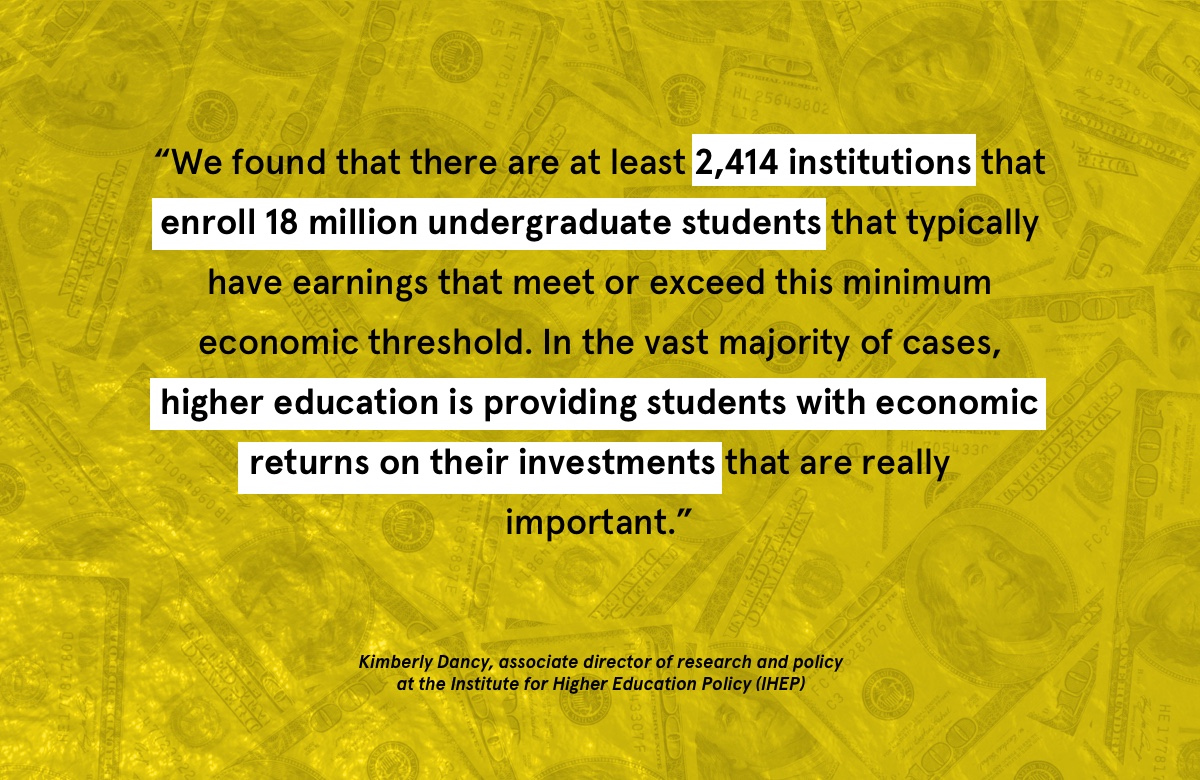For anyone who has navigated the labyrinth of college tuition payments over the past three to four decades, it’s no secret that higher education comes with a hefty price tag. This reality has prompted a growing chorus of voices to question the meteoric rise in costs and, more crucially, to explore potential remedies.
Navigating Higher Ed’s Rising Costs: Strategies for Affordability
What’s driving the relentless surge in college tuition costs, and are there promising solutions on the horizon to tackle this financial burden?

Government Disinvestment
Economists and policymakers are swift to underscore the decline in government funding for higher education in recent decades.
“The federal government and states have disinvested in higher education. This was particularly acute after the Great Recession. Understandably, they didn’t have enough money and they were looking for places to cut,” said Catherine Brown, senior policy director at the National College Attainment Network.
However, unlike healthcare and K-12 education, funding for higher education failed to rebound significantly post-recession.
As a consequence of the cuts, Kimberly Dancy, associate director of research and policy at the Institute for Higher Education Policy (IHEP), explained, the financial burden has shifted onto students and families. This trend, Brown noted, has precipitated an “explosion” in student debt.
The pullback in funding, Brown cautioned, is shortsighted.
“If you really want your state to be set up to compete with your neighbors and be a magnet for students from other states, having a very high-quality public system of colleges and universities is usually beneficial,” she said. “It’s really important to keep pace with the investments and that those investments keep the cost of tuition down for students.”
Results of Disinvestment
Tuition and fees now constitute approximately a quarter of the revenue of public institutions. Declining public funding per student has compelled institutions to rely more heavily on tuition revenue than in previous years, noted Armand Alacbay, chief of staff and senior vice president of strategy at the American Council of Trustees and Alumni (ACTA) and a member of the George Mason University Board of Visitors.
Between the 1980 and 2022 school years, Dancy elucidated, student costs have surged by 136%, even after adjusting for inflation.
“We have a situation where students and their families are really both paying a larger share of the college expenses that they are faced with and a situation where the total size of those expenses is increasing,” she explained.
With schools increasingly reliant on tuition revenue, a competitive landscape has emerged, particularly for students capable of paying full tuition, Alacbay observed. This, he contends, has catalyzed investments in infrastructure and amenities to attract such students, thereby driving up tuition costs for all.
Phillip Levine, the Katharine Coman and A. Barton Hepburn Professor in the Department of Economics at Wellesley College, concurred. He emphasized that public institutions are incentivized to invest in amenities such as lavish dorms and lazy rivers to court out-of-state students who pay premium prices with minimal institutional support.
“It’s not irrational, that’s an investment. It may not work. Not all investments do, but the goal is to raise money because they need it to help support the institution. At the end of the day, the problem is the money needs to come from someplace,” he said.
The increased burden on students has led some to question the value of higher education. Despite this, Dancy said IHEP’s research has found that college is still a good long-term investment in most cases.
“Rising Above the Threshold” looked at whether institutions are producing graduates who earn as much as a high school graduate plus enough to pay for their degree.
“We found that there are at least 2,414 institutions that enroll 18 million undergraduate students that typically have earnings that meet or exceed this minimum economic threshold, ” Dancy said. “In the vast majority of cases, higher education is providing students with economic returns on their investments that are really important.”

Private Institutions
Private institutions, particularly non-elite liberal arts colleges, face even more pronounced dependence on tuition and fees, which constitute roughly a third of their revenue, according to Alacbay.
Levine describes these institutions as being “stuck between a rock and a hard place.” Tuition-dependent private institutions can’t charge high-income students much more than their public counterparts do, with whom they directly compete, he added. As a result, private institutions with high sticker prices end up awarding significant merit grants to a large fraction of their students to bring the price to a competitive level.
“They can charge a little bit more because they do offer things that public institutions can’t offer as much of, like small classes, prettier campuses, access to faculty. People may be willing to pay extra for those advantages, but they are probably not willing to pay $30-40,000 extra,” he explained.
Without the cushion of higher-income students, these institutions struggle to subsidize tuition for low-income students, Levine said. They also don’t have much endowment support.
Alternatively, highly endowed private institutions use their endowment support to help pay the bills, Levine noted.
“It’s actually the one sector of the higher education landscape where lower-income students do pay affordable prices because of the very large endowment support those institutions can provide,” he said.
Despite the affordability of highly selective institutions for low-income students, their persistently high sticker prices are predicated on the ability of a significant proportion of students to pay full tuition, according to Nat Smitobol, an IvyWise college admissions counselor.
Increased Cost of Services
Many attribute the escalation in college tuition to rising institutional costs. A 2022 report from the State Higher Executive Officers Association identified higher instructional costs as a key factor driving tuition decisions.
“The costs of providing education have increased. If you look at the total per-student expenditures across institutions, we see those also going up over the last decade well beyond the rate of inflation,” Dancy explained.
Levine highlighted the wage inflation among highly educated personnel at institutions, which outpaces other sectors, as exacerbating the cost burden.
“In general, you face this problem that the costs of providing exactly the same services goes up over time,” he explained.
Despite the increased cost of instruction, Alacbay explained, there has only been a marginal increase in graduation rates.
“At public institutions, a 1% increase in instructional spending was correlated with only a tenth of a percentage point increase in graduation rates,” he said of findings from “In Cost of Excess.”
The last numbers published by the United States Department of Education found that the average public college had a 35% four-year graduation rate for the class of 2020, while the average private nonprofit four-year college had a 44% four-year graduation rate.
The “standard of care” that institutions offer has also increased over time, which has resulted in additional costs, David Feldman, professor of economics at William & Mary, noted in a 2017 Midwestern Higher Education Compact report.
“It’s a one-way ratchet,” he said. “Once you discover that something’s better, you can’t go back just because it’s cheaper.
Institutions are often quick to adopt new technologies to prepare students for the labor market.
Standard of care advancements also extend beyond the classroom, including counseling and career planning services and housing.
“Colleges have had to increase the quality of their lifestyle amenities merely to keep pace with the quality of lifestyle amenities of their students,” he said.
So-called “administrative bloat” has drawn scrutiny, with Alacbay cautioning against unnecessary administrative expenditures that inflate costs without commensurate improvements in education quality.
Levine tempered this critique, advising against simplistic attributions of tuition hikes solely to administrative expansion.
“It’s analogous to people talking about balancing the federal budget for five years by cutting fraud, waste and abuse. I’m not saying it doesn’t exist, but that’s not the problem,” he said.
Feldman added that there’s a truth embedded in a lie regarding the administrative bloat argument. Although the share of an institution’s workforce that is deemed as administrative has increased over time compared to professors, it’s worth considering who is classified as being in administrative positions.
“The IT staff is not instructional, it’s administrative. The professional staff counts as administrative. The number of IT staff that we have is certainly very different than what it was in the 1980s,” he said. “Maybe we should be a little bit more reticent about assuming an increase in the proportion of a college employee base that is not the professors is necessarily inefficient or bad.”
Increasing Pell Grant
Experts suggest that augmenting the federal Pell Grant funding could ameliorate affordability concerns.
When the Pell Grant launched in the 1970s, it covered three-quarters of the cost of a four-year public college. Today, it covers less than a third, Brown lamented.
“It’s not keeping up with inflation, and that’s a huge problem for students from low-income communities,” she said.
Doubling the grant, according to the IHEP report, could extend a minimum return on investment to students at an additional 95 institutions. President Joe Biden’s proposed 2024 budget, which includes a $820 increase in the Pell Grant, has been heralded as a step toward addressing affordability, according to Dancy.
An increase to the grant would also help close the affordability gap, Brown added. She pointed to research the National College Attainment Network published in “The Growing Gap” which found that the average unmet financial need at four-year institutions was $2,256 for 2020-21.
Most students who receive Pell Grants, Dancy noted, are from families making less than $35,000.
“That is an enormous amount of money for these families to try to come up with in order to just cover the remaining expenses that they owe to their institutions,” she said.
List Price vs. Net Price
Experts caution against fixating on colleges’ list prices, urging consideration of net prices after accounting for financial aid.
Based on a survey from the Association of American Universities, the public largely seems misinformed about who pays more for college, with 48% thinking that institutions charge the same for tuition regardless of family income.
“I think pretty much every discussion about the sticker price is misguided. Every single news article that you see that talks about college costs $90,000 a year. That’s just not true and it’s very damaging. Despite the fact that I think college is too expensive for low-income families, it’s nowhere near $90,000 a year,” Levine stressed.
In fact, for the 2023-24 school year, the average list price for in-state tuition at a public institution was $11,260 and $41,540 at a private nonprofit, according to a College Board report.
High list prices can scare away students, Brown noted.
“It’s counterintuitive that students won’t have to pay it,” she said of low-income students. “They go onto the website, and they see these high numbers. And they don’t want to take on a ton of debt, and they get scared off.”
Given the pricing discrepancies, Levine feels strongly that institutions should make that fact clear to lower- and middle-income families upfront.
Smitobol noted that institutions have tools at their disposal to market to different zip codes and regions.
“These tools allow colleges to target students from lower income brackets and send them marketing about affording their specific college,” he said.
Tools like net price calculators, which institutions are required to have on their websites, can help better inform students.
“They’re not always as visible as they could be, but it’s a really useful tool for students and families because, although it’s not perfect, it’s a pretty good way to estimate,” Brown said. “The more schools promote that tool, the more students can use it, the better.”
Although many students don’t often pay a college’s sticker price, ACTA found in its report that a rise in tuition is associated with a rise in net tuition. As long as sticker price is rising, Alacbay said, so is net tuition.
Prioritizing Affordability
Levine emphasized that, while lower- and middle-income students often pay less than anticipated, the financial burden remains significant.
“At four-year public institutions, a typical lower-income student with under $50,000 a year in income might face a cost of $15,000. That’s clearly unaffordable,” he stressed. He underscored that the focus should shift from the high tuition fees charged to high-income students to the formidable financial hurdle confronting lower-income students.
Dancy highlighted the multifaceted challenge of rising college costs, encompassing both upfront expenses and general living costs. She pointed out that these financial barriers, particularly for low-income students, could result in borrowing and employment while studying, potentially deterring enrollment and affecting degree completion.
Drawing attention to New Mexico’s Opportunity Scholarship, Dancy applauded its approach to prioritizing affordability. The program, a first-dollar initiative, permits students to utilize other forms of grant aid for additional expenses. If adopted nationwide at public institutions, the model could enable 44 additional colleges to enroll approximately 216,000 students meeting the minimum economic threshold as set out by the IHEP report.
“It’s a really promising approach, and it does a good job in terms of avoiding eligibility restrictions that are common in other free college programs and other sources of financial aid,” she said.
Defying expectations by maintaining or reducing tuition could provide institutions with a competitive advantage, Brown stressed.
“It seems like a terrific opportunity to say, ‘We’re vastly more affordable than other schools that are the same size and offer the same education.’ I’m waiting for more schools to do it,” she said.
Prioritizing affordability could play a pivotal role in addressing the looming demographic cliff. With institutions vying for a shrinking pool of students, particularly Gen Z, who are more risk-averse to college debt, tuition decisions are likely to be influenced by changing student preferences, Alacbay explained.
He also emphasized the fiduciary responsibility of trustees in ensuring college education remains financially accessible.
“Institutions should be concerned about how much students borrow—not just those who graduate, but for the worst-case scenario in which students take on tens of thousands of dollars of debt and leave without a degree,” he stressed.
Brown proposed state-level intervention, advocating for caps on tuition increases to align with inflation rates.
“Students are making decisions with their feet and that does have implications for schools. They are operating within a marketplace, and they should be responsive to it,” she said.
Positive Signs
Despite the challenges, there are glimmers of hope on the horizon.
Higher education recently reached parity with pre-Great Recession investment levels, Brown optimistically noted. A 2023 SHEEO report found that in 2022, public higher education appropriations increased 4.9% beyond inflation.
Alacbay added that there are some positive changes on the macro level. “The average inflation-adjusted tuition for both private and public four-year colleges has started to fall,” he said, pointing to national trends at HowCollegesSpendMoney.com
Newsletter Sign up!
Stay current in digital strategy, brand amplification, design thinking and more.
Recent in Student Experience
Also in Student Experience

The NIL Top 10: Who are the highest-paid college athletes?
Growing collective contracts and sponsorship deals have university athletes — both men and women — raking in record paydays.

College admissions try to balance innovation, ethics and equity.
As AI becomes more integrated into college admissions, institutions are navigating the challenges of maintaining fairness and transparency in the process.

Goodbye, US News? Alternative rankings are reshaping higher ed.
Alternatives like Colleges That Change Lives and FindaBetterU are shifting the focus from prestige to student satisfaction, campus culture and affordability.




